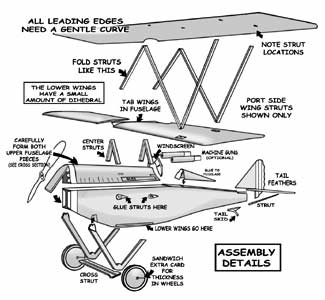


Ansaldo SVA WWI Italian Bomber

The Italian Ansaldo SVA was used during the later half of WWI and was was used more as a Bomber or recon reconnaissance machine than a scout. The engine, though powerful for it's time, was heavy resulting in performance that was not as impressive as the Allied Scouts like the French SPAD. The short wingspan made it quite unstable as well. Overall, it was an outstanding piece of aeronautical engineering and was used by Italy up until the early 1930s.
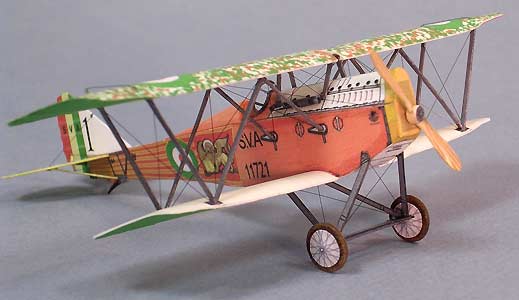
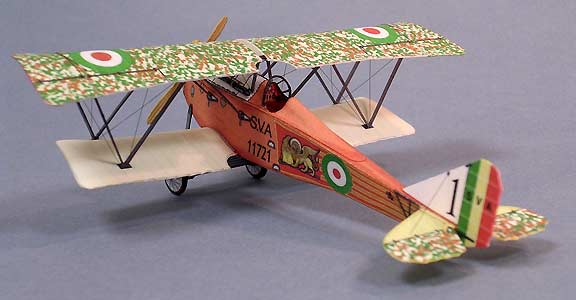
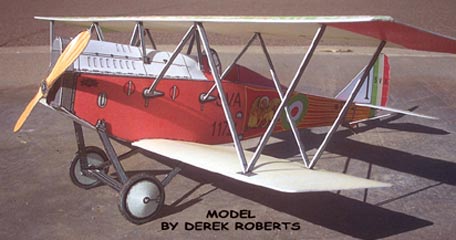 Derek
Roberts brought me back to the hobby. His models have a soul.
It is certainly the result of close observation but also
need to express beauty. The man is an artist. His Antoinette is
a masterpiece, with clever solutions and great beauty. Like a
work of art it gives joy and pride to be a human being. Merci Derek........
Jacques, Quebec.
Derek
Roberts brought me back to the hobby. His models have a soul.
It is certainly the result of close observation but also
need to express beauty. The man is an artist. His Antoinette is
a masterpiece, with clever solutions and great beauty. Like a
work of art it gives joy and pride to be a human being. Merci Derek........
Jacques, Quebec.
Gandalf, the Ansaldo is outstanding!The details are incredible. My hat's off to you. I just love the old stuff. Let 'em whine on the FG forum, keep 'em coming......T.
CHIP!!!!!! GREAT!! I love the new model and I am glad to see planes again...not that I don't like the buildings ....but....I really love the planes ..Thanks for all.....Ken T
THANK you,Chip! That looks like an exquisite model! Thanks for putting it up. That disk of yours was the best thing I ever bought. Do have a happy Christmas.......Ray P
Thanks for the Ansaldo, it's a beautiful model!! I got my first CD's last Friday and have already built the Portland Head Lighthouse,the Montauk, Ny Lighthouse and just started on the Yaquina Head model. This is a wonderful activity! I'm 62 and have done every kind of scale model building since I was a kid. These things are really fun to build, turn out great and with a little extra work on mounting bases, the complete diorama is very impressive! I'll be a paying customer for life and will soon start sending pictures of my work for your review. I built and flew radio control model airplanes for over 15 years and am therefore every interested in the airplanes offered. Being a Lighthouse nut, I hope you will continue to add new models! Thanks again for a great product and great service!..... Rick F
Chip, first thanks for the new model. Second the Italians WERE the Allies; the SVA harassed the Austrians and other Central Powers. ..I know a critic in every email........ Tom
Looks like Derek has come through again with a great little model.. WWI Italian Bomber WOW !!!! H.Crown12/14/04
.Man, your work is fine ...I'm working on your Ansaldo and all I can say is its a work of elegance ...I'm honestly in love with the cowlings...And I'm in love with the fuse...Oh, I'm also in love with the wings...Aw hell, I'm loving' the whole damned thing...This model is right up there with the Tommy and the Spad series...What a sweet and sexy bird...The WWI Bipeds are still my favorites and the Ansaldo is just one more reason why... Z.. 12/21/04
The Ansaldo looks like a detailing dream. Great work. D Caldwell 12/22/04
The Ansaldo is excellent. I love the lion on the side .I think all of the World War I stuff is great. The paint schemes are so colorful. Anything new in the works? I'd like to see a Handy Page bomber. J Dell 12/17/04
The larger models in the folder is shown above with a wingspan of 9.5 inches This model was designed by our English Artist-Designer, Derek Roberts.
The Ansaldo SVA WWI Bi-Plane reconnaissance-Bomber
Chip, Nick
& Gang, Are you ready to get down to work for 2005? We had
some nice days, so I was able to photograph the Ansaldo. Here
are two shots, maybe you can use one. I'm sure there's going
to be great work, as usual, coming from Fiddlersgreen in 2005!
Happy New Year, Dick 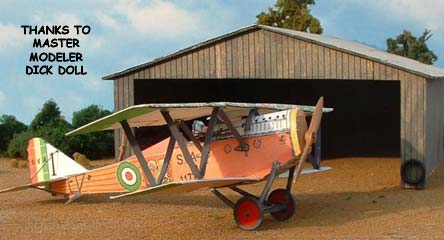 |
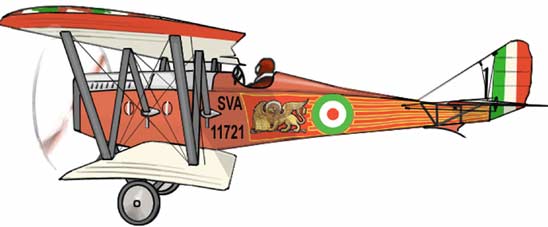
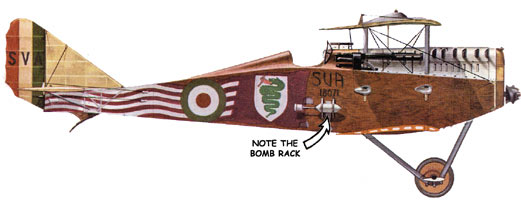 The S.V.A. (Savoia Verduzio Ansaldo) aeroplanes were built
by the Societa Ansaldo of Genoa and Turin. In the summer of 1917
the S.V.A.5 single-seater fighter was designed by Verduzio. Its
power unit, the 220 h.p. SPA 6A engine, had a rectangular frontal
radiator and six exhaust stubs which discharged on the starboard
side of the nose. The wing's had the usual wooden spars and ribs,
internally wire-braced and covered with fabric; the top wing had
no dihedral and carried the ailerons, which were of unequal chord;
the lower wing had dihedral and a shorter span. There was no center
section, the cabane struts being of the trestle type. Inter plane
bracing consisted of tubular struts which formed a Warren truss
in front elevation; a system which resembled the bracing arrangements
of the ill-fated aeroplanes designed by Professor Knoller for
Austro-Hungary. No flying or landing wires were necessary.
The S.V.A. (Savoia Verduzio Ansaldo) aeroplanes were built
by the Societa Ansaldo of Genoa and Turin. In the summer of 1917
the S.V.A.5 single-seater fighter was designed by Verduzio. Its
power unit, the 220 h.p. SPA 6A engine, had a rectangular frontal
radiator and six exhaust stubs which discharged on the starboard
side of the nose. The wing's had the usual wooden spars and ribs,
internally wire-braced and covered with fabric; the top wing had
no dihedral and carried the ailerons, which were of unequal chord;
the lower wing had dihedral and a shorter span. There was no center
section, the cabane struts being of the trestle type. Inter plane
bracing consisted of tubular struts which formed a Warren truss
in front elevation; a system which resembled the bracing arrangements
of the ill-fated aeroplanes designed by Professor Knoller for
Austro-Hungary. No flying or landing wires were necessary.
The plywood-covered fuselage was long in relation to the wing span. Forward of the cockpit it was flat-sided; from cockpit to tail it tapered gradually in both the horizontal and vertical planes, the vertically tapered sides meeting to form a knife-edge to which the tail-skid was attached. The top of the cowling and the fuselage top decking conformed in section to the shape of the pilot's head and shoulders, so that by moving his head slightly he had a good view in most directions. A small tail-plane and plain rounded elevators were fitted; the fin was triangular and the plain rudder had a 'scalloped' trailing-edge.
The undercarriage vees were unusually wide. Twin Vickers guns were mounted in the grooves in the top of the cowling, in front of the cockpit; on some machines they were well forward and inaccessible during flight.
The first S.V.A.s were delivered to fighter training schools in autumn 1917. Early in 1918, however, it was decided to use the type as a long-distance strategic reconnaissance aero plane, and operational flights began in March. The S.V.A.5 was the perfect machine for this role, having plenty of lift to carry heavy fuel loads, and more than enough speed to shake off enemy fighters. The best of the S.V.A. units was the 87a Squadriglia, 'La Serenissima' -the Venice squadron, whose aircraft carried the Lion of St. Mark on their fuselage sides.
Many amazingly long flights were carried out by S.V.A. pilots.
On May 21st, 1918, Tenente Lo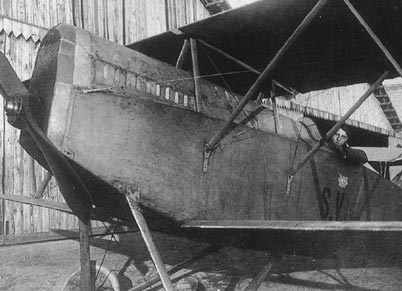 catelli and Ferrarin flew to Fried
richshafen, photographed the airship sheds and returned to their
base-a distance of 440 miles.
catelli and Ferrarin flew to Fried
richshafen, photographed the airship sheds and returned to their
base-a distance of 440 miles.
Locatelli went to Zagreb and back, a distance of 562 miles,
on June 24th. The most famous operational trip took place in August,
when seven S.V.A.5s escorted a two seater S.V.A.9 all the way
to Vienna, returning unscathed to their point of departure, after
a journey of 625 miles. Reconnaissance and bombing raids were
also made on Bolzano, Innsbruck and Franzenfeste. All these flights
involved dangerous mountain
crossings.
In 1915 the Italians had built a series of biplanes, the Savola-Pomillo, which were far from brilliant in their performance; after this experience, the DTAM recognized the need for designing a new aircraft based on sound structural and aerodynamic principles.
Such research was carried out in the summer of 1916 by Umberto Savola and Rodolfo Verduzio, assisted by Celestino Rosatelli. All structural details were carefully calculated, and when the design was complete it was turned over to the Ansaldo Corp. of Genoa.
In December 1916 Ansaldo began building the prototype, which
differed from the blueprints in its improved tall structure and
the adoption of a single front radiator, similar to an automobile
radiator, instead of two radiators 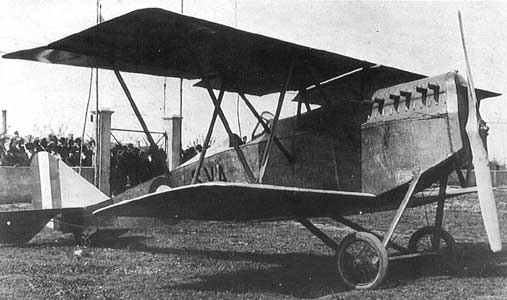 mounted between fuselage and
upper wing, as in the original design. In spite of the many initial
difficulties, the 200 workmen at the Ansaldo plant at Borzoll
Mare were able to complete the prototype by March 1917, to a great
extent through the work of an engineer named Brezzi, a particularly
energetic man who was also the director of the Ansaldo plant.
mounted between fuselage and
upper wing, as in the original design. In spite of the many initial
difficulties, the 200 workmen at the Ansaldo plant at Borzoll
Mare were able to complete the prototype by March 1917, to a great
extent through the work of an engineer named Brezzi, a particularly
energetic man who was also the director of the Ansaldo plant.
The first SVA was transferred from Borzoli to an airfield at Grosseto, where it was test-flown by Sgt. Mario Stoppani on March 19, 1917. In the following weeks the SVA was put through a series of rigorous tests and certain defects were corrected while the testing staff awaited the arrival of other machines from the Ansaldo factories at Borzoli and Bolzaneto.
During the summer the first batch of SVAs was tested by military pilots, who found them wanting in maneuverability but in compensation found them capable of higher speeds than they had been able to achieve with the Hannot HD.1 and SPAD VII fighters. Similar results were reported from the front, where the SVA had met the slower but more agile enemy planes. The decision was quietly made to assign the SVA to missions where its virtues could be used to the best advantage.
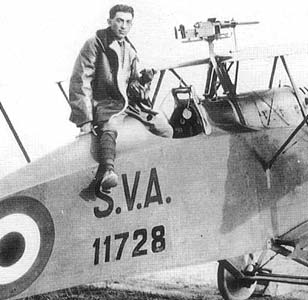
Technical Description
The SVA was a biplane, originally a single-seat with a two-bladed tractor propeller, and with the whole airframe built entirely of wood. From the very beginning the SVA had a characteristic appearance, due to the use of a series of diagonal internal struts and the nearly total lack of wire bracing.
The wings were of double-spar construction, extra ordinarily thin (and intentionally so, to maximum efficiency while minimizing drag).
Another identifying characteristic was the flared upper wings. Both main planes were covered with fabric, either linen or silk, and the struts were of streamlined steel tubing. One detail which distinguished the first SVA from those built later was the presence of of rounded cutouts in the trailing edge of the two wings, above the cockpit and at the wing roots, to improve visibility upwards and on landing. Only the upper wing had ailerons. The tall structure was similarly of wood and fabric, with a variable- incidence stabilizer which could be set on the ground according to the load carried. Some SVAs had tail planes of tubular steel structure.
The fuselage was of curious construction, of rectangular cross section ahead of the wings and a triangular cross section aft of the cockpit. The design improved downward visibility in flight, The fuselage, a truss structure covered with plywood was especially sturdy, and the design had been carefully worked out in an effort to achieve optimism aerodynamics.
The pilot's cockpit was roomy and comfortable and its instrumentation normally included a tachometer, an oil pressure gauge, a fuel gauge, a magneto selector, a choke and fuel mixture control.
The undercarriage was a simple structure of metal tubing bolted directly to the fuselage longerons .The tail skid consisted of a metal spring section.
A boosted version of the SVA 5 was also built in 1918, powered by a 250-hp Isotta-Fraschini V.6 engine. With this engine the SVA 5 could achieve 146 mph, and returned an excellent overall flight performance with outstanding climbing capability.
Another experimental engine tried out in the spring and summer of 1918 was the 220-hp Lorraine Dietrich. Several machines fitted with this engine were built, but the Lorraine- Dietrich version did not go beyond the prototype.
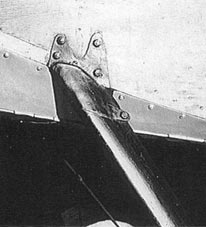 How the SVA was used in the War
How the SVA was used in the War
On February 28, 1918, four SVAs from the Prima Sezione (First Section) of the Italian air arm, consisting of three aircraft carrying a pair of 55-1b bombs each and one machine with reduced wing spa . And equipped with vertical aerial photographic cameras took off from the airfield of Ponte San Pietro. The pilots were Capts. Palli and Palma di Cesnola, Lieut. Orsini and Sgt. Arrigoni. After a 155-mile flight over the Alps they reached Innsbruck in Austria, where they dropped their bombs and shot up the railroad marshaling yards. After three hours' flight they were back at their base.
This bombing of Innsbruck, the first successful such action of any appreciable importance, clinched the reputation of the SVA with Italian pilots, and soon each of the six army commands had its own 'Sezione SVA' (SVA group). In addition to these, there had also been activated early In 1918 a special squadron, the 87a Squadriglia, under the High Command.
This strategic reconnaissance unit flexed its muscles with a series of flights along the Alpine valleys known as Val di Non, Val d'Adige, Passo della Mendola and Valsugana, then on May 21 1918 it carried out its first long-range mission. Two SVAs piloted by Arturo Ferrarin and Antonio Locatelli penetrated to Lake Constance on the Swiss- German -Austrian border, where they photographed the important industrial center of Fried richshafen.
The international fame of the SVAs was established, however,
in the famous 'Vienna Raid' dreamed up by Gabriele d'Annunzio,
a rather extravagant poet of the time who fancied himself a warrior.
He had wanted to have 'his' raid flown by Caproni tri motor bombers,
but the scheme was opposed by the Italian High Command, since
to use such 'heavy aircraft' would mean exposing valuable crews
to unnecessary dangers. At the same time, using the SVA two-seater's
would have complicated the whole scheme beyond the point of minimum
feasibility.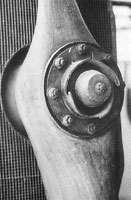
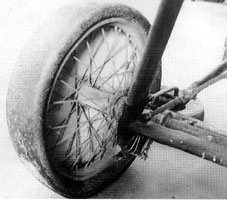
However, when d'Annunzio got to know what the SVA 5 was capable of performance- wise he began to plan his exploit around these biplanes. The big problem was to give two-eaters of the SVA 5 variety a flight endurance of 7 hours, the time necessary to get to Vienna and back. Ansaldo got interested in the problem and solved it by equipping an SVA 9 with a special fuel tank holding 300 liters (66 imperial gallons), enough to get the poet to his dream objective and home.
Eleven modified SVAs set out on the morning of August 9, 1918, from the airfield at San Pelagio. Eight of these arrived at the target, piloted by Palli, Locatelli, Massoni, Allegri, Censi, Sarti, Granzarolo and Finzi, with d'Annunzio riding along with Palli. Sarti was forced to make an emergency landing in enemy territory, while the others went on to take reconnaissance photographs of Vienna and to toss out propaganda leaflets which d'Annunzio had written in his customary high-flown prose.
This flight, which seems only picturesque today, had an extraordinary psychological effect on the enemy. Apart from that by showing what they could do, the SVAs had marked a milestone in the development of military aviation which impressed both Allies and the enemy.
In the autumn of 1918 operational use of the SVAs was increased, and new squadrons were added to the Italian air arm: the 56th, 57th and 84th Reconnaissance and Bombing Squadrons and two sezioni equipped with SVA two-seater's. At the same time, other SVAs were being flown by pilots of the 111a and 116a Squadriglie in Macedonia and Albania.
The Italian Navy, which had acquired seaplane versions of the SVA (ISVA), based them at Venice, Varano, Brindisi, Valona, Civitavecchia, Taranto and Bolsena, and used these machines as escorts to their ships and for long-range reconnaissance. This navy group later became known as the 'Squadrl'glia San Marco' (St. Mark's Squadron), named after the patron saint of Venice. The Navy was also the only branch of the Italian military service to use SVA fighters, basing some at Brindisi and La Spezia as port defense and others at Jesi, Ferrara and Grottaglie to protect dirigible hangars. Other SVAs were assigned to the 193a Squadrl'glia Mista ('Mixed Squadron') at S. Vito dei Normanni and at Valona. All of these units participated in the intense campaign of reconnaissance and bombing which was carried out in the autumn of 1918, against enemy troop concentrations and supply routes to the front.
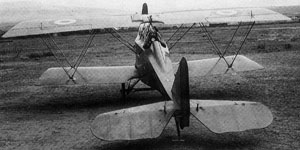 In these late campaigns, Italy lost some of her most famous
pilots: Locatelli, forced down in enemy territory and captured;
Allegri, killed in a collision with Lieut. Vianini; Contratti,
shot down in a dogfight with four Austrian fighter planes. During
the decisive Battle of Vittorio Veneto the SVA squadrons took
an active part in the action, especially in the strafing of enemy
ground troops and installations.
In these late campaigns, Italy lost some of her most famous
pilots: Locatelli, forced down in enemy territory and captured;
Allegri, killed in a collision with Lieut. Vianini; Contratti,
shot down in a dogfight with four Austrian fighter planes. During
the decisive Battle of Vittorio Veneto the SVA squadrons took
an active part in the action, especially in the strafing of enemy
ground troops and installations.
At the time of Armistice (November 4, 1918, in Italy) there were several hundred SVAs in service, and new ones were arriving from the factories at the rate of about 250 per month. By the end of 1918 a total of 1200 SVAs and 50 ISVAs, the seaplane version, had been built. In the winter following the war production was reduced to a few machines built at Canfiere (Plant) No. 5. All of these planes took part in the postwar development of the SVA concept.
SVAs took part in many civilian air races and other events in the postwar period, and some Italian feats merited the attention of other nations: Locatelli piloted his SVA over the Andes, while Ferrarin and Cappannini flew from Rome to Tokyo, a distance of 11,000 miles.
These feats were good for public relations, and soon SVAs had been sold to Argentina, Brazil, France, Lithuania, Latvia, Holland, Peru, Poland, the Soviet Union, Spain and the United States.
When production of SVAs was terminated in 1928, a total of 2000 had been built. The final version was the SVA 10. These aircraft were active until 1929 in police work, and along mail routes and general communications in Africa, where they were successful although they had not been designed with tropical conditions in mind.
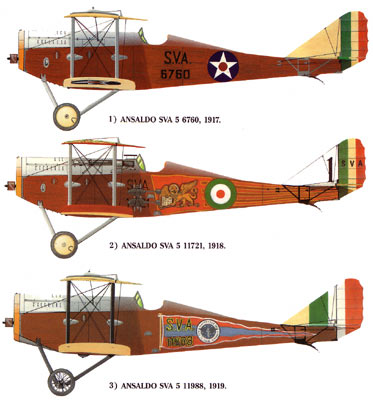
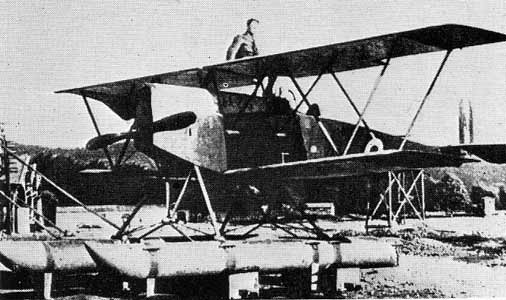
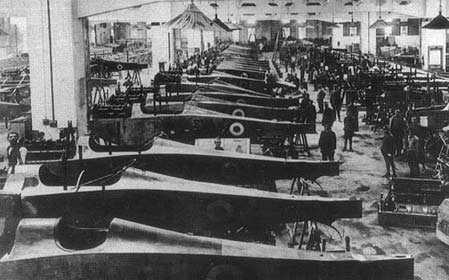
Specifications of the Ansaldo S.V.A. 5
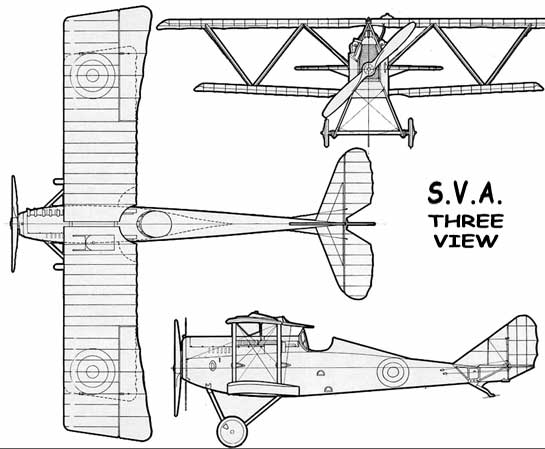 |
Length: 26 ft 7 in |



